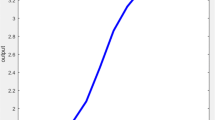Abstract
An adaptive fuzzy controller was developed to control the glucose and glutamine concentrations in the reactor constant at the desired level. The parameter values of the controller change during the cultivation according to the culture phase which was detected by the lactate concentration. Cultivations with different glucose and glutamine set point concentrations of a recombinant BHK anchorage-dependent cell line were performed in a fed-batch reactor on-line connected with an HPLC system. Glucose and glutamine concentrations were satisfactorily controlled at each set point during all cultivation periods. Ammonia had a determining effect on productivity since it inhibited cell growth and protein specific production. Ammonia production increased with an increase of glutamine or a decrease of glucose set point concentrations, indicating the importance of glucose to glutamine ratio for the optimization of productivity in mammalian cell cultures.
Similar content being viewed by others
References
Dalili M, Sayles GD and Ollis DF (1990) Glutamine-limited batch hybridoma growth and antibody production: Experiment and model. Biotechnol. Bioeng. 36: 74–82.
Frame KK and Hu WS (1988) A model for density-depended growth of anchorage-dependent mammalian cells. Biotechnol. Bioeng. 32: 1061–1066.
Gaertner J and Dhurjati P (1993) Fractional factorial study of hybridoma behavior. 2. Kinetics of nutrient uptake and waste production. Biotechnol. Prog. 9: 309–316.
Glacken MW (1988) Catabolic control of mammalian cell culture. Bio/technology 6: 1041–1050.
Glacken MW, Fleischaker RJ and Sinskey AJ (1986) Reduction of waste product excretion via nutrient control: Possible strategies for maximizing product and cell yields on serum in cultures of mammalian cells. Biotechnol. Bioeng. XXVIII: 1376–1389.
Hu WS, Dodge TC, Frame KK and Himes VB (1987) Effect of glucose on the cultivation of mammalian cells. Develop. Biol. Standard. 66: 279–290.
Konstantinov KB and Yoshida T (1990) An expert approach for control of fermentation processes as variable structure plants. J. Ferment. Bioeng. 70: 48–57.
Kurokawa H, Ogawa T, Kamihira M, Park YS, Iijima S and Kobayashi T (1993) Kinetic study of hybridoma metabolism and antibody production in continuous culture using serum-free medium. J. Ferment. Bioeng. 76: 128–133.
Kurokawa H, Park YS, Iijima S and Kobayashi T (1994) Growth characteristics in fed-batch culture of hybridoma cells with control of glucose and glutamine concentrations. Biotechnol. Bioeng. 44: 95–103.
Ljunggren J and Häggström L (1994) Catabolic control of hybridoma cells by glucose and glutamine limited fed batch cultures. Biotechnol. Bioeng. 44: 808–818.
Luan YT, Mutharasan R and Magee WE (1987) Effect of various glucose/glutamine ratios on hybridoma growth, viability and monoclonal antibody formation. Biotechnol. Letters 9: 535–538.
Mamdani EH and Assilian S (1975) An experiment in linguistic synthesis with a fuzzy logic controller. Int. J. Man-Mach. Stud. 7: 1–13.
Miller WM, Wilke CR and Blanch HW (1988) Transient responses of hybridoma cells to lactate and ammonia pulse and step changes in continuous culture. Bioprocess Eng. 3: 113–122.
Ogawa T, Kamihira M, Yoshida H, Iijima S and Kobayashi T (1992) Effect of dissolved oxygen concentration on monoclonal antibody production in hybridoma cell cultures. J. Ferment. Bioeng. 74: 372–378.
Park YS, Shi ZP, Shiba S, Chantal C, Iijima S and Kobayashi T (1993) Application of fuzzy reasoning to control of glucose and ethanol concentration in baker's yeast culture. Appl. Microbiol. Biotechnol. 38: 649–655.
Schneider M, Marison IW and von Stockar U (1996) The importance of ammonia in mammalian cell culture. J. of Biotechnol. 46: 161–185.
Shaughnessy TS and Kargi F (1990) Growth and product inhibition kinetics of T-cell hybridomas producing lymphokines in batch and continuous culture. Enzyme Microb. Technol. 12: 669–675.
Shiba S, Nishida Y, Park YS, Iijima S and Kobayashi T (1994) Improvement of cloned α-amylase gene expression in fed-batch culture of recombinant Saccharomyces cerevisiae by regulating both glucose and ethanol concentrations using a fuzzy controller. Biotechnol. Bioeng. 44: 1055–1063.
Wagner A, Marc A, Engasser JM, Villermaux S and Einsele A (1990) Continuous production of prourokinase in feed harvest and perfusion cultures. Biotechnol. Bioeng. 36: 623–629.
Wang J, Honda H, Lenas P, Watanabe H and Kobayashi T (1995) Effective tPA production by BHK cells in nutrients-controlled culture using an on-line HPLC measuring system. J. Ferment. Bioeng. 80: 107–110.
Wentz D, and Schügerl K (1992) Influence of lactate, ammonia and osmotic stress on adherent and suspension BHK cells. Enzyme Microb. Technol. 14: 68–75.
Zielke HR, Ozand PT, Tildon JT, Sevdalian DA and Cornblath M (1978) Resiprocal regulation of glucose and glutamine utilization by cultured human diploid fibroblasts. J. Cell. Physiol. 95: 41–48.
Rights and permissions
About this article
Cite this article
Lenas, P., Kitade, T., Watanabe, H. et al. Adaptive fuzzy control of nutrients concentration in fed-batch culture of mammalian cells. Cytotechnology 25, 9–15 (1997). https://doi.org/10.1023/A:1007950002663
Issue Date:
DOI: https://doi.org/10.1023/A:1007950002663




